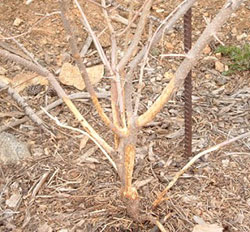Adapted by Eric Hammond, Adams County Extension, from the CO-Horts blog originally authored by Irene Shonle, Gilpin County Extension.

There are many burrowing animals in Colorado that can cause damage to lawns, gardens, and pastures. The first step to resolving the problem is to figure out which animal (or animals) caused the damage. The main four types of burrowing animals are voles (8 species), pocket gophers (4 species), prairie dogs, and Wyoming ground squirrels. Moles are rarely found in Colorado, and only in the very eastern plains. If you are outside that area, the species causing damage is one of the other four. Voles and pocket gophers are amongst the most common.
Voles
Voles cause several types of damage. They gnaw on bark of trees and shrubs, sometimes girdling it entirely and causing the death of trees. Most damage occurs in the winter when voles move through their grass runways under the protection of snow. The greatest damage seems to coincide with years of heavy snowfall.
Vole damage to trees and shrubs is characterized by girdling and patches of irregular patterns of gnaw marks about 1/16 to 1/8-inch wide. Gnawed stems may have a pointed tip.
Other signs of damage by voles include: 1- to 2-inch-wide runways through matted grass with open 1-2 inch holes and spongy soil from burrowing activity. Voles remain active all year round
Pocket Gophers

Pocket gophers rarely appear above ground, spending most of their lives in burrows. Prairie dogs and Wyoming ground squirrels, on the other hand, are frequently seen above ground.
The mounds that pocket gophers create are fan-shaped to round and usually have closed entrances, unlike prairie dogs and Wyoming ground squirrels. The main signs of damage from pocket gophers include mounds of soil (with no apparent hole), eskers (solid tubes of soil) above ground when the snow melts in the spring, and suddenly wilting plants (due to root damage). The tunnels are usually 2.5-3.5” in diameter, and are usually found in the top 4-18” of soil.
Refer to the following fact sheets for help with dealing with voles and pocket gophers:



